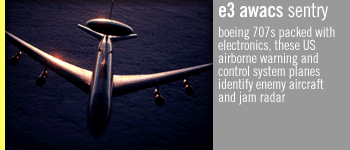



 The E-3 Sentry is the most sophisticated airborne command post ever devised. The airframe chosen for the job was the Boeing Model 707, which was equipped with state-of-the art electronics inside and topped with a 30-foot rotating radome. The aircraft are designated AWACS; the acronym stands for Airborne Warning and Control System.
The E-3 Sentry is the most sophisticated airborne command post ever devised. The airframe chosen for the job was the Boeing Model 707, which was equipped with state-of-the art electronics inside and topped with a 30-foot rotating radome. The aircraft are designated AWACS; the acronym stands for Airborne Warning and Control System.
The first of two dozen E-3A Sentrys were delivered in 1977, and all 24 went into service on January 1, 1979. Although flown by the Air Force tactical Air Command, they first saw duty with the joint U.S./Canadian North American Air Defense Command (NORAD).


An improvement program begun in 1984 has seen the A model superseded by the E-3B and the E-3C. The improvements have included more situation display consoles (SDC), a better radar jamming system, and an upgraded Joint Tactical Information Distribution System (JTIDS) and Tactical Digital Information Link (TADIL).
The Boeing E-3 Sentry is 153 feet long, 42 feet high, and has a wingspan of 146 feet and a maximum take-off weight of 325,000 pounds. Four Pratt and Whitney TF33-PW-100/100A turbofan engines each deliver 21,000 pounds of thrust. Top speed is 530 miles per hour; maximum range is 7,475 miles; service ceiling is 29,000 feet.
As discovered when a U.S. Navy warship shot down an Iranian civilian passenger airliner over the Persian Gulf in 1988, battlefield electronics are only as good as the people who operate them. Similarly, the decisions people make in the heat of battle are only as good as the information they receive. This makes IFF (Identification, Friend or Foe) recognition of aircraft a vital part of the AWACS task. Upon detecting enemy aircraft, the E-3s can vector friendly fighters to optimal attack position.
The E-3 is also used to guide bombers to their targets. In Operation Desert Storm, the AWACS planes formed an interlocking, yet noninterfering, network of command posts able to manage the hundreds of warplanes that might be conducting attack sorties and combat air patrols at any given moment.
From: Gulf War - A Comprehensive Guide to People, Places & Weapons by Col. Walter J. Boyne, U.S. A.F. (RET) Signet, 1991

home · oral history · war stories · weapons · maps · chronology
tapes & transcripts
FRONTLINE · wgbh · pbs online
web site copyright WGBH educational foundation
 |  |